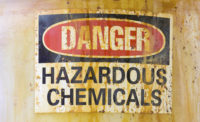CSB wants big changes in Calif. refinery regulations

 The U.S. Chemical Safety Board (CSB) recommends substantial changes to the way refineries are regulated in California in its final Regulatory Report on the Chevron Richmond Refinery pipe rupture and fire. Among them: the Board wants California to enhance its process safety management (PSM) regulations for petroleum refineries to ensure a more robust and adaptive regulatory regime.
The U.S. Chemical Safety Board (CSB) recommends substantial changes to the way refineries are regulated in California in its final Regulatory Report on the Chevron Richmond Refinery pipe rupture and fire. Among them: the Board wants California to enhance its process safety management (PSM) regulations for petroleum refineries to ensure a more robust and adaptive regulatory regime.
The August 2012 process fire in the crude unit at the Chevron refinery in Richmond, California endangered 19 workers and sent more than 15,000 residents to the hospital for medical attention.
Missed opportunities
The CSB’s investigation of the incident found that Chevron repeatedly failed over a ten-year period to apply inherently safer design principles and upgrade piping in its crude oil processing unit, which was extremely corroded and ultimately ruptured on August 6, 2012. The CSB identified missed opportunities on the part of Chevron to apply inherently safer piping design through the use of more corrosion-resistant metal alloys as well as a failure by Chevron to identify and evaluate damage mechanism hazards, which if acted upon, would likely have identified the possibility of a catastrophic sulfidation corrosion-related piping failure. There are currently no federal or state regulatory requirements to apply these important preventative measures. The investigation team concluded that enhanced regulatory oversight with greater worker involvement and public participation are needed to improve petroleum refinery safety.
CSB to keep an eye on California's PSM revisions
Following the Chevron Richmond refinery incident, the state of California has worked to revise and strengthen its PSM requirements. On September 9, 2014, the State of California Department of Industrial Relations, Division of Occupational Safety and Health (Cal/OSHA) released its Draft Process Safety Management for Refineries Regulation. The draft regulation includes a number of more rigorous requirements. The draft regulation incorporates a risk-reduction goal of “the greatest extent feasible” for process hazard analyses and proposes significant new requirements such as performing damage mechanism reviews and hierarchy of controls analysis.
Chairperson Moure-Eraso added, “California’s draft regulations address numerous issues raised in the CSB regulatory report, and the CSB will be monitoring the California rulemaking process closely to see if those provisions remain in the final rule.”
Across the pond
At a January 2014 public meeting in Richmond, CA the board approved a motion to allow for additional study of this incident. Since that time CSB staff and board members have traveled to the UK to fully study regulatory regimes of onshore and offshore facilities in the UK – amongst a number of issues staff examined workforce participation, continual improvement and transparency issues as the currently exist in the UK. The CSB staff outlined these actions in a white paper available at www.csb.gov.
Investigator Amanda Johnson said, “The CSB’s regulatory report concludes that under the existing U.S. and California regulatory systems, there is no requirement to reduce risks to a specific target, such as, for example, to as low as reasonably practicable, or ALARP – similar principles have been adopted in Europe and Australia in the refinery and chemical sectors, as well as the nuclear and space sectors in the U.S.” Such a target would also require adaptability and continuous improvement which is vital in responding to newly discovered hazards and lessons from chemicals incidents.
"Reactive" regulation did not work
Dr. Rafael Moure-Eraso said, “The current regulatory system for process safety is largely reactive, at both the state and federal level; companies have a default right to operate, and are subject to penalties when accidents occur or their activities otherwise draw negative attention from regulators. In the case of the Chevron refinery fire, the reactive system of regulation simply did not work to prevent what was ultimately a preventable accident.”
The regulatory report details how attributes of a more robust and adaptive process safety management approach would greatly enhance existing state and federal process safety regulations. Such attributes include a more comprehensive process hazard analysis; documented use of inherently safer systems analysis and the hierarchy of controls to the greatest extent feasible with the goal of continuous risk reduction to a specified risk target; analysis of the effectiveness of safeguards intended to control hazards; the effective use of process safety indicators that drive performance; and more thorough inspections and audits by a technically qualified regulator.
The CSB notes that these enhancements would provide the adaptability necessary to keep current with improving standards and advancing technology, without requiring lengthy and often unproductive rulemaking on the part of the regulator.
Effective implementation of this system requires strong workforce involvement, proactive inspections and enforcement by a well-resourced regulator, as well as incorporation of best practice performance standard requirements. Don Holmstrom, director of the CSB’s Western Regional Office noted that the Chevron report recommends significant improvements to empower workers and their representatives. “The report recommends that the regulator recognize worker safety representatives who have the right to participate in improvements to process safety and if necessary have the legal authority to stop unsafe work—the Chevron incident showed these reforms are sorely needed.”
A step in the right direction
Chairperson Moure-Eraso said, “Workers, the public and the industry itself would benefit from an adaptable, robust and effective regulatory approach. The recent bipartisan law passed last month by the California legislator to provide regulators with detailed information concerning extensive maintenance overhauls and repair operations at refineries within the state is certainly a step in the right direction.”
Looking for a reprint of this article?
From high-res PDFs to custom plaques, order your copy today!





